D&M
T:400-991-6008
零售與服務空間設計的邊界
?
— Hi設計專訪店與面創始人&創意總監邱啟平
在見到邱啟平之前,我一直對店與面這家廣州的設計機構抱有一份好奇。究竟是什么魅力一直吸引著像海爾、美的、蘇寧、阿里健康、愛爾眼科等一大批知名品牌與他們合作,而且有很多品牌的合作一直持續十幾年。
直到來到店與面,與創始人、創意總監邱啟平交流之后,從下午3點半聊到晚上10點半,7個小時下來,才慢慢感知到這背后的故事,以及他們在市場上的價值主張是什么。
作為國內幾乎是最早在商業零售空間設計方向深耕的專業機構,他們理性、克制,那些隱藏在設計語言背后,經過對市場深刻洞察之后的策略能力,以及將策略與創意、設計整合起來的系統化交付才是他們在激烈的市場中存在并持續獲得如此多知名品牌青睞的真相。
Before meeting Qiu Qiping, I had always been curious about Shop & Face, a Guangzhou-based design agency. What is the charm that has been attracting a large number of famous brands like Haier, Midea, Suning, Ali Health, Aier Eye and so on to cooperate with them, and many of them have been cooperating for more than ten years.
It was only after coming to Shop & Face and communicating with the founder and creative director Qiu Qiping, from 3:30 pm to 10:30 pm, 7 hours down, that I slowly perceived the story behind this and what their value proposition is in the market.
As a professional agency that was almost the first in China to plow deeply in the direction of commercial retail space design, their rationality and restraint, their strategic ability that is hidden behind the design language, after deep insight into the market, and their systematic delivery that integrates strategy with creativity and design are the truth that they exist in the fierce market and continue to gain the favor of so many famous brands.
很多時候,人的職業生涯充滿了故事感和戲劇性。
時間回溯到10多年前的2008年,那一年,邱啟平迎來了他人生中一次重要的機遇。
向他們團隊拋來橄欖枝的是海爾集團,品牌方希望邱啟平他們公司來設計世博會展館。那時的邱啟平盡管在空間領域做過許多案例,但這樣的項目還是頭一次碰到。時間緊, 任務重,在設計工作室只有 3 人的情況下,大膽地接下了項目。接下來的時間,就是連著加班,累了直接睡公司,醒來接著干。快提案時,邱啟平帶著臺式機去了青島, 在酒店辦公,連續2晚沒睡覺,通宵做圖,最后的方案贏得了客戶的贊許。
在后續執行過程中,為完成內部空間的裝修跟進,邱啟平帶著團隊連續7天吃住在世博館,最后,邱啟平在項目的完成度以及配合方面贏得客戶的極致好評。
Many times, a person's career is full of stories and drama.
Back in 2008, more than 10 years ago, Qiu Qiping had an important opportunity in his life.
The brand wanted Qiu Qiping and his company to design the Expo pavilion. Although Qiu had done many cases in the field of space, this was the first time he had encountered such a project. With a tight schedule and a heavy workload, Qiu boldly took on the project with only three people in the design studio. The rest of the day was spent working overtime, and when he was tired, he went to bed and woke up. When the proposal was almost ready, Qiu Qiping went to Qingdao with his desktop computer and worked in a hotel, staying up for two nights in a row, working on the drawings overnight.
In the follow-up process, Qiu Qiping took his team to live and eat in the Expo Hall for 7 days in order to finish the interior decoration.
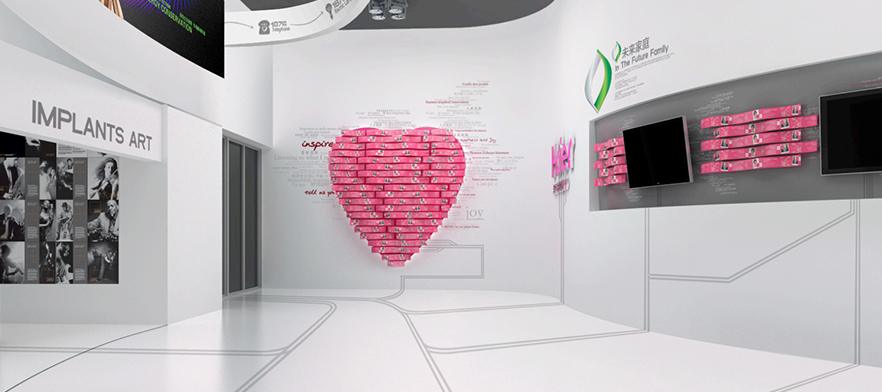
創業的美好就是在于挑戰后被認可的價值感,在那次之后,包括海爾在內,許多品牌合作源源不斷地找上門來,邱啟平因此真正踏入了零售空間設計領域。邱啟平把公司名字定位:店與面,就是為了能在業務范圍和方向上顯著的區別其他設計公司。 從創業之初一直走到今天,店與面已經成為諸多500強品牌的戰略合作伙伴。也因為深耕這個領域,成為中國商業零售與消費市場發展獨特的見證者和觀察者。
作為這個團隊的領隊,邱啟平一直對市場有著特別敏銳的洞察和深度的思考。他發現,伴隨著電商發展和新零售概念的崛起,這幾年零售空間的設計在發生非常大的變化。
商品交付流程的變化極大影響著線下實體空間的設計邏輯。零售空間越來越多的強調體驗。所以,在他眼里,商品零售空間的設計與服務空間的邏輯的邊界開始變得模糊,這也為他們找到了新的市場機會。
但他也有些疑惑,過去傳統零售空間中設計的理性部分被越來越多的感性的空間構建所取代。他始終覺得,沒有內在的理性邏輯,那些感性的表象語言非常容易被透支,品牌的投入越來越大,但獲得的只是曇花一現的網紅感。在他眼里,基于邏輯的創作才是設計師需要持續堅持的那根金線。 我想,這是店與面的核心能力,也是他們對自己價值觀的堅守。
The beauty of entrepreneurship is the sense of value that comes with the challenge of being recognized, and after that time, many brands, including Haier, came to us in a steady stream of collaborations, which led to Qiu Qiping's real entry into the retail space design field. Qiu Qiping positioned the name of his company, Shops & Faces, in order to distinguish itself from other design firms in terms of its scope and direction. From the beginning of the company to today, Shop & Face has become a strategic partner for many Fortune 500 brands. It has also become a unique witness and observer of the development of China's commercial retail and consumer market because of its deep involvement in this field.
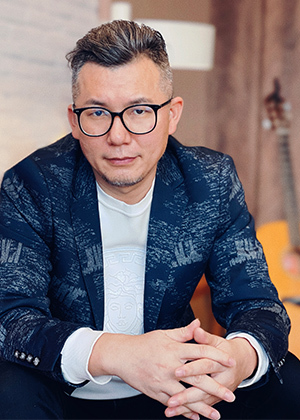
對話店與面創始人邱啟平
Q=邱啟平 ,H=Hi設計
品牌更強調用戶在線下空間的體驗和情緒價值
H:人貨場三要素的變化改變了線下商業空間的功能、效率等,您如何看待近幾年過年零售空間的變化?
Q:尤其是最近5-10年,伴隨著互聯網電商領域的發展與進步,傳統的家電的營銷與渠道發生了很大變化。我們的了解,國內某個我們服務過的品牌,十年前他們的線下傳統渠道的銷售占比是80%,但是近年來線上渠道占比80%,正好反過來了。
這些變化背后,影響著零售空間的設計方向,對設計機構也帶來一些挑戰和新的機遇。挑戰是說,從整體的門店數量方面,品牌在大幅的減少線下傳統門店的數量和預算。另一方面,品牌客戶在旗艦店、體驗店、概念店方面的預算在增加,對設計在商業空間里的價值更加認可。
H: The changes in the three elements of people, goods and space have changed the function and efficiency of the offline commercial space, how do you see the changes in the retail space in recent years over the years?
Q: Especially in the last 5-10 years, along with the development and progress of the Internet e-commerce field, the marketing and channels of traditional home appliances have changed a lot. Our understanding, a domestic brand we have served, ten years ago their offline traditional channel sales accounted for 80%, but in recent years the online channel accounted for 80%, exactly the opposite.
These changes affect the design direction of retail space and bring some challenges and new opportunities for design agencies. The challenge is that, in terms of the overall number of stores, brands are drastically reducing the number of traditional offline stores and their budgets. On the other hand, brand clients are increasing their budgets for flagship stores, experience stores, and concept stores, and are more aware of the value of design in commercial spaces.
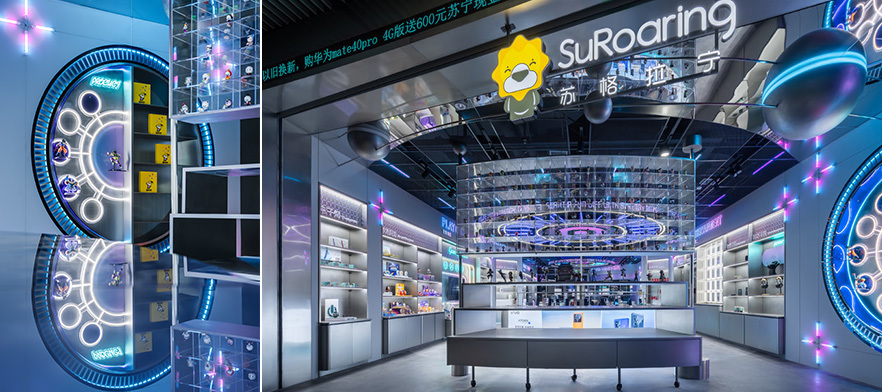
H:從這些變化背后,您有什么樣的洞察和思考?
Q:你會看到現在的門店它真正的交付不是在場一定要銷售給顧客產品。從顧客角度來說,如果只是需要獲得某個產品,可選擇的途徑太多了。但如果顧客要真正體驗到產品的價值,只在線上并不能夠完全解決。只有在線下實體門店,才能體驗到真實的產品和品牌價值。很多產品交付的環節發生在線上,但是影響顧客做出消費決策和對品牌體驗的完整體現卻必須依賴更多維的線下空間。
從設計方面講,品牌在線下門店的訴求方面,不再過于強調以產品交付效率為核心目標的導向,而轉變為品牌價值、客戶體驗、客戶互動等方面的顧客服務和情緒體驗價值新導向。傳統零售空間越來越服務化,與服務體驗空間的邊界變得越來越模糊。
H: What kind of insight and thinking do you have behind these changes?
Q: You will see that nowadays the store it really delivers is not present necessarily to sell products to customers. From the customer's point of view, if they just need to get a certain product, there are too many ways to choose. But if the customer wants to really experience the value of the product, only online is not a complete solution. Only in offline physical stores can we experience the real product and brand value. A lot of the product delivery happens online, but the complete reflection of the consumer decision and brand experience must rely on the more multi-dimensional offline space.
In terms of design, brands no longer place too much emphasis on the efficiency of product delivery as the core goal of their offline stores, but instead shift to a new orientation of customer service and emotional experience value in terms of brand value, customer experience, and customer interaction. The traditional retail space is becoming more and more service-oriented, and the boundary with the service experience space is becoming more and more blurred.
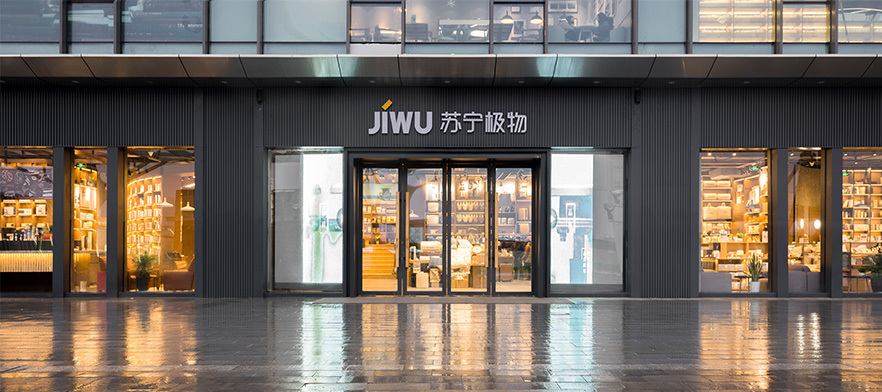
家電零售空間越來越倡導個性化和場景化
H:家電零售空間的設計趨勢是什么?
Q:近年來,中國家電零售空間的設計趨勢主要有以下幾個方面
第一個是數字化和智能化:隨著智能家居和物聯網技術的普及,越來越多的家電零售店開始引入數字化和智能化元素。
第二個就是個性化和場景化:越來越多的家電零售店開始倡導個性化和場景化的消費理念,通過創造不同的場景來呈現產品的不同用途,例如展示廚房、臥室、客廳等不同場景的家電產品。這樣消費者更容易了解產品的實際使用效果,提高購買欲望。
我們有一個概念叫空間及故事發生地。就是通過一條故事線和情節的設計融入到不同的產品特點,觸達到用戶的情緒點里,把客群對于產品的關注,融合進品牌的解決解決方案中,最后上升到用戶的情緒關注點。
我們希望品牌不是單純的售賣產品,更應該關注的產品和提供的服務。例如,現在一些品牌的高定類產品必須依賴線下,是線上替代不了。這些產品,品牌方需要的是一整套解決方案的輸出,在線上是賣不出去的,需要一個場景化、智能化的零售空間。
第三個就是家電開始泛家居化:所以更需要空間設計的時候體現產品的特點和場景的融合。所以,一個好的門店設計,不單純關注空間本身,更要關注到產品開發的那一刻,需要慮到未來品牌和客戶交流溝通的場景。
H: What are the design trends of home appliance retail space?
Q: In recent years, the design trends of home appliance retail space in China are mainly in the following aspects
The first is digitalization and intelligence: with the popularity of smart home and IoT technologies, more and more home appliance retail stores are introducing digital and intelligent elements.
The second is personalization and scenario-based: more and more home appliance retail stores are advocating the concept of personalization and scenario-based consumption by creating different scenarios to present different uses of products, such as displaying home appliances in different scenarios such as kitchen, bedroom and living room. This makes it easier for consumers to understand the actual use of the product and increase their desire to buy.
We have a concept called space and the place where the story takes place. It is through a story line and the design of the plot into different product features, to reach the emotional point of the user, the customer's concern for the product, integrated into the brand's solution solution, and finally rise to the user's emotional concern.
We hope that brands are not just selling products, but should also focus on the products and services they provide. For example, some brands now have to rely on offline for their high definition products, which are not replaceable online. These products, the brand needs a full set of solutions output, online is not sold, need a scene, intelligent retail space.
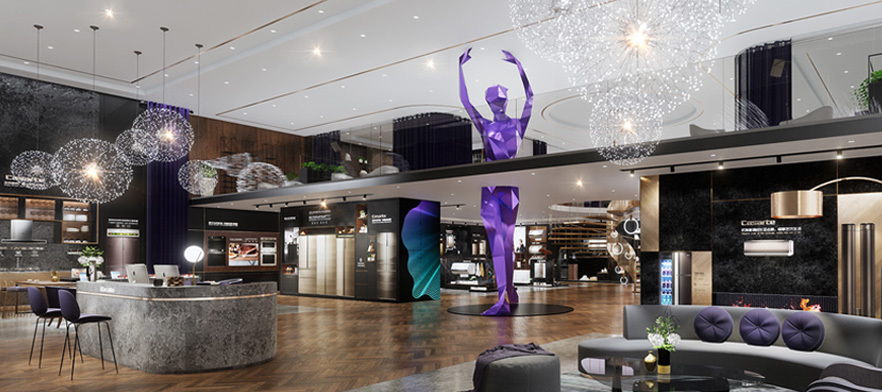
零售與服務空間邊界變得越來越模糊
H:從最初做家電零售品牌,到現在擴展到健康、醫美等領域,面對不同的市場與客戶,設計層面有哪些不同嗎?
Q:商業消費空間,通常理解有兩類,第一種是為品牌產品的展示的空間,在這里主要是以滿足產品的交付為主要功能的空間,第二種是以服務、價值、體驗為導向的這種商業空間,例如醫美,我覺得它強化的是一種服務價值。
一個是給你交付產品,一個是給你交付完整的一個服務的流程。看似它有很大的差異,但是我覺得背后面核心創作邏輯,它其實是相通的。最核心的一點,我個人認為主要是價值的輸出,最后客戶來到這個空間,最終都是需要得到一個愉快的體驗,無非是體驗的結果不同,一個是要有形的產品,一個是要愉悅的滿足感。
從這個角度,品牌方和設計師的出發點和側重點有所不同,作為設計師,我們最關注的是消費者客群在空間里面得到了什么樣的體驗,什么樣的價值認同。這一點才是我們所要思考。從底層思考,不管是普通的商品零售空間,還是以服務空間,本質的邏輯是一致的。
H: From initially being a home appliance retail brand, to now expanding to health, medical and aesthetic fields, what are the differences in design level in the face of different markets and customers?
Q: Commercial consumer space, there are usually two types of understanding, the first is for the brand product display space, where the main function is to meet the product delivery space, the second is the service, value, experience-oriented business space, such as medical beauty, I think it strengthens the value of a service.
One is to deliver a product to you, and the other is to deliver a complete process of service to you. It seems to have great differences, but I think the core creation logic behind it is actually similar. The core point, I personally believe that the main value of the output, the final customer to this space, the final need to get a pleasant experience, only the result of the experience is different, one is to have a tangible product, one is to be pleasant satisfaction.
From this perspective, the starting point and focus of the brand and the designer are different. As designers, we are most concerned about what kind of experience and value recognition the consumer customers get in the space. This is what we have to think about. Thinking from the bottom, no matter it is a normal commodity retail space or a service space, the essence of the logic is the same.
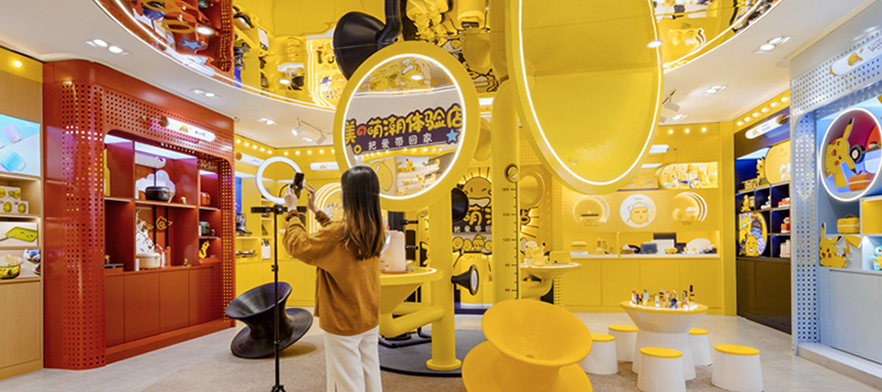
H:基于這種洞察,我們有哪些項目實踐呢?
Q:2022年,我們幫愛爾眼科集團做了一個新的品牌叫愛爾西柚。我們通過大量的調研和分析發現,盡管人們來到眼科醫院表面上是為了治療近視眼,但底層的洞察讓我們看到,治療眼睛都動機是為了方便和美。
基于這樣的洞察,我們發現空間需要觸達客群,特別是年輕人,需要重塑一個新的空間形態。我們覺得空間不再是診所和醫院的概念,而是一個發現和制造美的場所。
所以,我們第一步是構建了一個零壓力的社交空間,來滿足觸達客戶與用戶溝通交流的功能,在這里勾起用戶好奇心,來幫助客戶在線下獲客。
H: Based on this insight, what are some of our project practices?
Q: In 2022, we helped Aier Eye Group with a new brand called Aier Grapefruit. We found through extensive research and analysis that although people come to eye hospitals ostensibly to treat their nearsightedness, the underlying insight showed us that treating the eyes is all motivated by convenience and beauty.
Based on this insight, we found that the space needed to reach out to the clientele, especially the young, and needed to reinvent a new space form. We felt that the space was no longer a clinic or hospital concept, but a place to discover and make beauty.
Therefore, our first step is to build a zero-pressure social space to meet the function of reaching out to customers and communicating with users, where we can arouse their curiosity to help them gain customers offline.
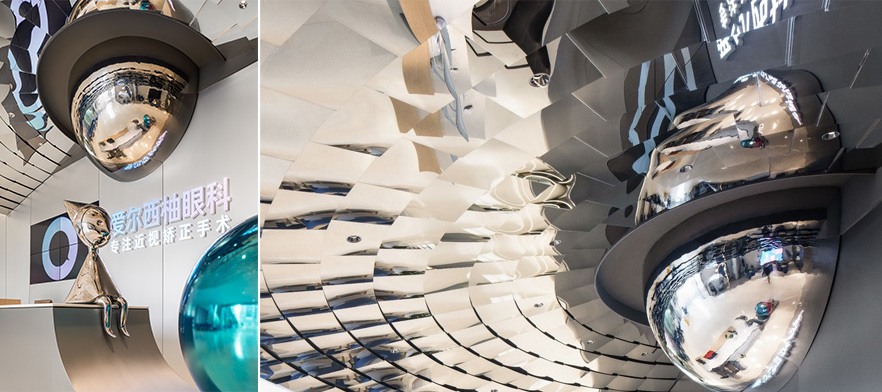
第二步是建立信任空間,把專業的設備、檢測流程等開放出來,用一個玻璃的透明空間呈現業務,讓顧客有參觀感。
第三步就是幫助顧客來做決策。這個時候,我們賦予顧客更多的VIP體驗,充分把品牌情感傳遞給顧客,并且把美學課堂等一些活動空間合理的安排在體驗動線里,讓顧客做出充分的零壓力的決策。
盡管這些設計背后,我們都會圍繞如何幫助品牌與顧客之間溝通,但從思考開始到策略制定再到最后的空間設計落地,我們顛覆了傳統醫美空間的設計邏輯,以顧客為核心,塑造了一個新的醫美空間。
The second step is to build trust space, open out the professional equipment, testing process, etc., and present the business with a glass transparent space, so that customers have a sense of visit.
The third step is to help customers to make decisions. At this time, we give customers more VIP experience, fully convey the brand emotion to customers, and reasonably arrange some activity spaces such as aesthetic classroom in the experience dynamic line, so that customers can make full zero-pressure decisions.
Although behind all these designs, we will focus on how to help communication between the brand and customers, but from the beginning of the thinking to the strategy development to the final space design landing, we overturned the traditional design logic of medical beauty space and shaped a new medical beauty space with customers as the core.

H:這種思路背后有哪些具體的做法呢?
Q:我們提出了一個概念叫重構體驗。我們通過體驗觸點的梳理,然后打散現有的邏輯關系,把所有的邏輯關系都碎片化。然后再根據我們的目標和思考,重構不同碎片,重新組合出一套全新的解決方案。
這個思路背后,會發現我們設計的每一個環節都指向一個目標,而所有的功能都是可以打散的,這種重塑后的邏輯,在加上空間、材料、關系、色彩等設計語言的表現,會在理性與感性之間找到共識,更好地解決客戶需求。
這個思路背后,會發現我們設計的每一個環節都指向一個目標,而所有的功能都是可以打散的,這種重塑后的邏輯,在加上空間、材料、關系、色彩等設計語言的表現,會在理性與感性之間找到共識,更好地解決客戶需求。
H: What are the specific practices behind this thinking?
Q: We came up with a concept called reconfiguring the experience. We sort through the experience touchpoints and then break up the existing logical relationships and fragment all of them. Then, according to our goals and thinking, we reconstruct the different fragments and recombine them to come up with a new set of solutions.
Behind this thinking, it will be found that every aspect of our design points to one goal, and all functions can be broken up. This reshaped logic, when coupled with the performance of design languages such as space, material, relationship and color, will find consensus between rationality and sensibility, and better solve customer needs.
Behind this idea, it will be found that every aspect of our design points to one goal, and all functions can be broken up. This reshaped logic, when coupled with the expression of design languages such as space, material, relationship, and color, will find a consensus between rationality and sensibility, and better address customer needs.
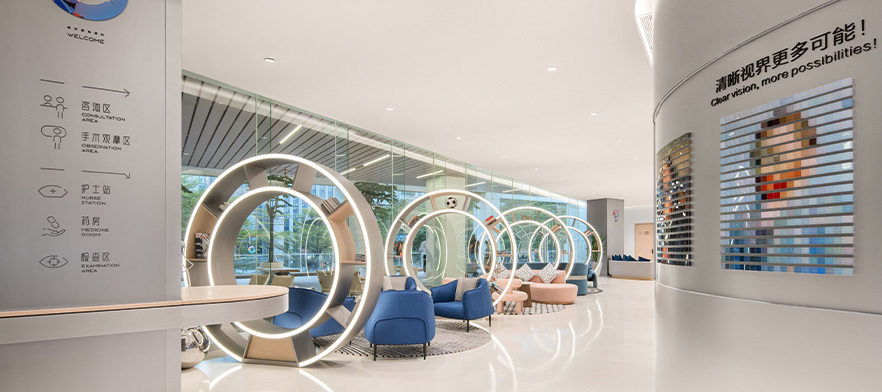
讓零售空間創新更有趣有效
H:店與面有一句話叫讓零售空間創新更有趣有效,是不是就是這樣來體現的?
Q:是的。因為我們發現,我們一大堆和客戶講的都是有效性,客戶也希望聽到這些。因為這是他們的核心關注點,你不管怎么樣,最終指向還是有效。但僅僅只是講有效性,對于用戶來講的話,你會發現看到這個品牌和另外一個品牌是沒有區別的。
品牌需要有很鮮明的品牌個性。所以,我們提出有趣的概念。不是簡單的樂趣,而是更高階的空間體驗。空間不只是容器,是產品體驗的延伸。關注藝術給人的情緒,探尋空間藝術化和商業可持續性的平衡創造“每一瞬間都是唯一”。就是圍繞顧客如何讓他感興趣。
H: There is a saying in Store & Face that makes retail space innovation more interesting and effective, is that how it comes across?
Q: Yes. Because we find that a whole lot of what we talk to clients about is effectiveness, and clients want to hear that. Because this is their core concern, no matter what you do, the final point is still effectiveness. But just talking about effectiveness, for users, you will find no difference between this brand and another brand.
Brands need to have a distinctive brand personality. Therefore, we propose the concept of fun. Not simply fun, but a higher-order space experience. Space is not just a container, it is an extension of the product experience. We focus on the emotion that art gives to people, and explore the balance between space art and commercial sustainability to create "every moment is unique". It's all about how to make the customer interested.

H:您認為店與面的核心競爭力是什么?
Q:其實,你發現不管設計機構還是品牌方,大家都在談「客戶體驗」,但是能夠真正把策略、設計表現和顧客體驗結合的很好,都做到出色的并不多。我們的核心競爭力,其實就是把策略、創意和設計語言整合起來共同構建以客戶需求、客戶體驗為導向這種系統化交付能力,我覺得這是店與面最核心的競爭力所在。
H: What do you think is the core competitiveness of stores and facades?
Q: In fact, you find that no matter design agencies or brands, everyone talks about "customer experience", but not many of them can really combine strategy, design performance and customer experience well and do it all excellently. Our core competitiveness is to integrate strategy, creativity and design language together to build a systematic delivery capability oriented to customer needs and customer experience, which I think is the core competitiveness of Shop & Face.
-- - end